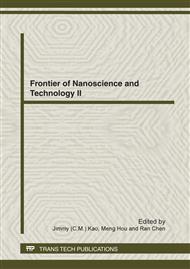p.39
p.43
p.50
p.54
p.58
p.64
p.71
p.75
p.80
Preparation of Liuweidihuang Nano-Microcapsules and its Physicochemical Properties
Abstract:
To prepare out a novel preparation of liuweidihuang which effectively preserves Paeonol, Ursolic acid and Polysaccharides, and the preparation process should be scientific, lower-price and simple. The microscopic characteristics and its physicochemical properties of super-micro-particle of liuweidihuang from above process were also discussed. Methods According to the therapeutic and physicochemical properties of materials in liuweidihuang, the processed technology is as follow: Ripe rehmannia glutinosa,Tuckahoe and Alisma digitalis were boiled for 4.5h., the root bark of the peony tree(Paeonia suffruticosa), dogberry and yam were smashed to nanoparticles. Then select the reasonable method to drying the mixture. The microscopic shape characteristics of the before- and after- broken particles was compared. Paeonol content and dissolution were determined by HPLC. The stability and fluidity of liuweidihuang nanoparticles were examined by precipitation and funnel way. Results The approach of prepared liuweidihuang nano-microcapsules is scientific, lower-price and simple. The average size of processed super-micro-particle of liuweidihuang is 400±46nm. The hardness of the table is 9.7kg/cm2. The thickness of the table is 0.6cm. The friability of the tablet is <1%. Each tested item complied with standards of troches of Chinese medicine, and it is beneficial to industrial production for Chinese medicine.. Conclusion The nano-microcapsule is dispersive, desiccative, mobilizable, stable and three times concentrated than traditional pills of Liuweidihuang. It also can be used to produce different forms of drugs in the market.
Info:
Periodical:
Pages:
58-63
Citation:
Online since:
June 2012
Authors:
Price:
Сopyright:
© 2012 Trans Tech Publications Ltd. All Rights Reserved
Share:
Citation:


